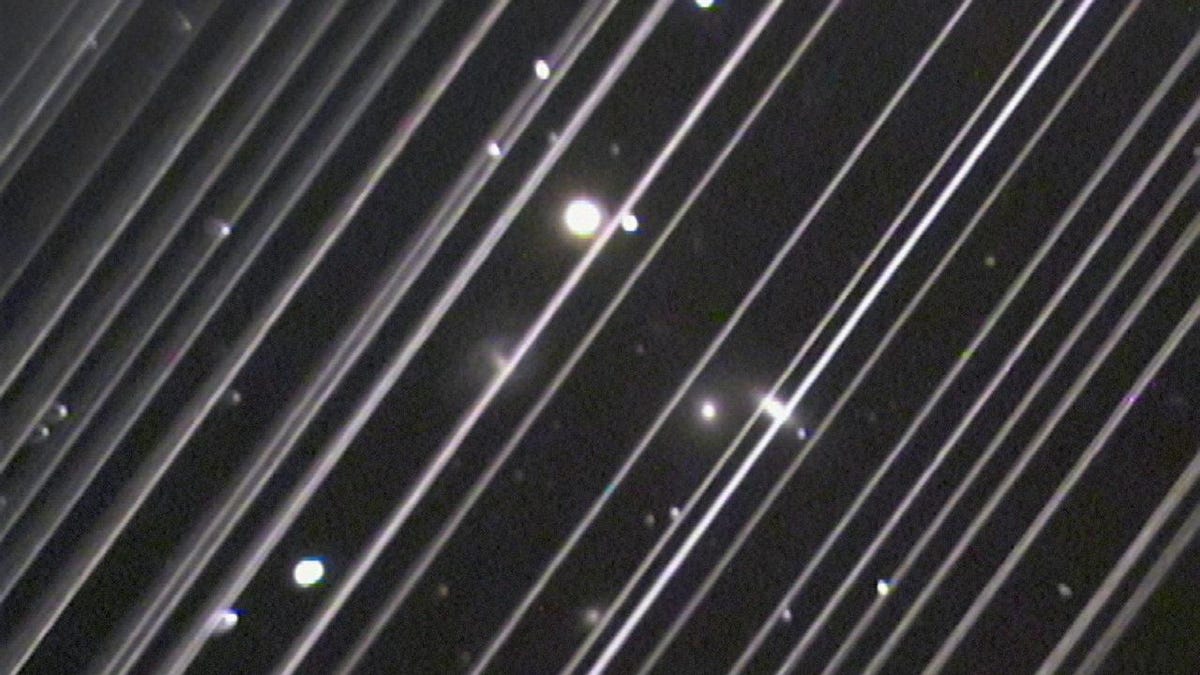UFO sighting boom is coming thanks to SpaceX and OneWeb
People worldwide are already reporting unidentified lights in the sky as Starlink gets off the ground. It could be just the beginning.

This image of a distant galaxy group from Arizona's Lowell Observatory is marred by diagonal lines from the trails of Starlink satellites shortly after their launch in May.
Last year saw a big increase in a certain kind of UFO spotting, and in 2020 the trend is likely to explode, thanks in part to Elon Musk.
Around the world, thousands of people reported seeing a train of unidentified bright lights moving steadily in formation across the night sky.
The thing is, these aren't actually unidentified flying objects: They're SpaceX Starlink satellites climbing to a low-earth orbit, where they'll sail above us en route to eventually providing broadband access around the globe.
SpaceX already has about a hundred of its small satellites aloft, with plans to launch another batch of 60 satellites on Monday, then 60 more in a couple weeks, and then again a couple weeks after that. The goal is to keep adding to the orbiting fleet in the months and years to come; the entire mega-constellation could eventually number up to 40,000 satellites, according to documents filed with regulators.
Okay so...
— SarahTheKitten (@sarahthekitten) December 29, 2019
For those who saw strange lights above the UK sky..
I've figured it out.
Its the "Starlink Train" (satellites) which i think was launched by Space X (Elon Musk?)
It is a VERY rare sight.
I had high hopes for it being a #UFO👽👽👽https://t.co/pZGCHVn8Yg
With only two batches of the flying routers above us so far, Starlink has already spurred a big response from both astronomers catching the trains in their scientific observations and UFO spotters who aren't quite sure what they're seeing.
Reports of UFO's in Bideford, if you did happen to see a string of lights don't panic, it was SpaceX Starlink Satellites! https://t.co/8X9wQQpAHN pic.twitter.com/HJ2K9M8Sk0
— North Devon News (@NorthDevonNews) December 29, 2019
UFO sighting databases are filled with numerous entries describing "a long train of lights" or "bright spots with constant speed in a straight line"
"For the time being, we have included in our database of sightings the several hundreds of reports we received about the cluster, principally to illustrate how easy it is to cause human observers to be deceived by a new, and eye-catching, visual phenomenon," the National UFO Reporting Center wrote on its website last month.
@IDADarkSky: This evening I could observe #Starlink satellites. A composite of 188s exposure time of the Cassiopeia constellation showing the negativ #lightpollution effect they will have... pic.twitter.com/tWOmcrToMi
— Andreas Hänel (@andhaenel) December 30, 2019
Monday's launch of 60 Starlink satellites will include one with a nonreflective coating that SpaceX hopes will reduce the visibility of the satellites. The company has been working with major astronomical organizations to reduce the constellation's impact on telescopic observations of space, and the new coating will serve as a test of one possible solution.
"We are going to get it done," SpaceX President and COO Gwynne Shotwell told reporters last month. "[We'll] do trial and error to figure out the best way to get this done."
In the meantime, dozens or even hundreds more Starlink satellites could be launched that are just as bright and reflective as the first two batches.
And this is to say nothing of Starlink competitor OneWeb, which is also ramping up its own broadband constellation. A launch of 32 satellites is planned for February, followed by two more identical launches in the first half of the year.
It all adds up to a sky that's going to get a lot more crowded in 2020, with a lot more to see. So spread word that those weird lights in a line are just another Elon Musk project, not aliens building a railroad in the sky.

